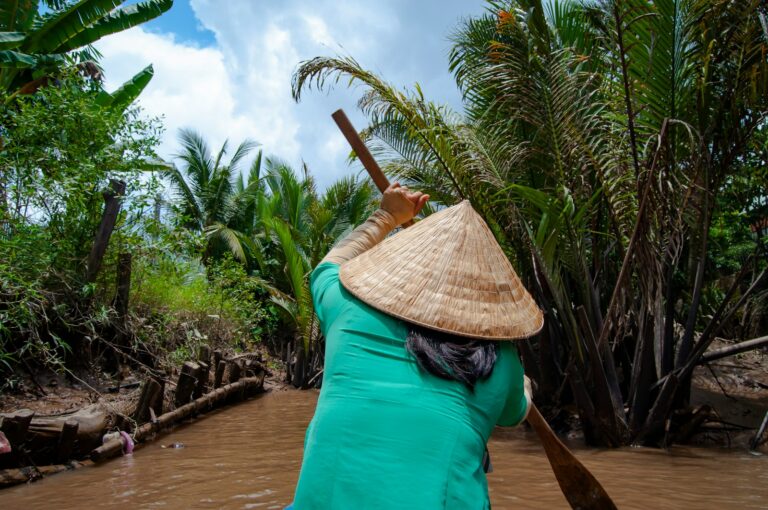The Luffa Revolution: How a Humble Vine is Becoming Asia’s Greenest Export
In Vietnam’s Mekong Delta, a young entrepreneur is turning a simple plant into a global solution for plastic pollution—and that’s just the beginning.
A Seed of Change in Thanh Binh
Thanh Binh district, Dong Thap province. Rice paddies shimmer in the late afternoon sun, and a chorus of cicadas fills the air. But amid this traditional landscape, something modern and revolutionary is sprouting: rows of luffa vines climbing toward the sky—and promises of a greener future.
Here, Do Dang Khoa, now 30, tends to luffa like a caretaker of both land and destiny. He smiles as he gently brushes his fingertips over the mature, fibrous gourds hanging heavy on the trellis. “It’s not just about products,” he says softly. “It’s about making choices that matter—for people and for the Earth.”
Beyond Business: A Genuine Mission
What began as a small, family workshop has become Thao Minh—a company co-founded with his mother, Nguyen Thi Dep. Their mission? To prove that eco-friendly living doesn’t mean sacrificing quality or style.
From bath sponges and shoe insoles to kitchen brushes and pet toys, their luffa-based products generate more than VND 60 million (~US$2,400) per month. Yet for Khoa, the real success lies in the clean alternatives they offer to PP and PE plastics. Each item that replaces single-use materials is a small victory for the Mekong Delta and beyond.
Khoa works hands-on with local farmers, ensuring the luffa is grown sustainably and fairly. “When we work together,” he explains, “the land, the farmers, and the community all thrive.”
Tradition Woven into Innovation
Long before eco-fashion and biodegradable trends hit big, Nguyen Thi Dep was creating intricate decorations from dried flowers and natural fibers. Each piece was an ode to Vietnamese tradition—elegant, meaningful, and entirely handmade.
Her insistence on craftsmanship over mass production set a firm foundation. That commitment resonated far beyond Vietnam’s borders: Thao Minh’s pet toys have charmed Japanese customers for over seven years, while their dried-grass décor has found fans in the United States. These successes, she says, “prove that the world still craves products with soul—authentic, sustainable, and beautiful.”
Winning Green: Local Roots, Global Recognition
In late 2023, Khoa and his colleagues—Đỗ Mạnh Quân and Lê Na—entered the prestigious 9th Green Start-up Competition with their project, “Connecting People with Nature – Mr Luffa.” They beat 36 others to win first prize: VND 150 million (~US$6,160) (vietnamnews.vn, Global Agriculture). This wasn’t just about a cash reward. The victory brought OCOP certifications (3- and 4-star) and opened doors to retail chains like AEON in Japan, and exports to South Korea and Japan (Global Agriculture).
Now, as Khoa eyes future scale-up—with plans to convert Thao Minh into a joint-stock company—he knows the potential is massive. “Green products are a global trend,” he says, “and we want to bring our products—and our message—to the world.”
Vietnam’s Advantage: Craftsmanship and Innovation
Vietnamese luffa producers like Thao Minh and the newer Green Fiber (based in Dak Lak’s basalt lands) are combining artisanal skill with modern methods (eloofah.com). Green Fiber, for example, showcased at Vietnam’s Global Sourcing Fair in April 2025, presenting bath textiles, kitchenware, pet toys—and leaving lasting impressions on international buyers (eloofah.com).
This rise illustrates Vietnam’s sweet spot: strong traditional craftsmanship, yet open to biotechnology, high-quality packaging, and closed-loop manufacturing systems (Coffee wood chew, eloofah.com). Consumers in Europe, Japan, and North America are increasingly drawn to products that feel meaningful and responsible.
Global Innovation: Luffa Goes High-Tech
Vietnam isn’t the only country embracing luffa’s potential. Across the world, entrepreneurs are turning this simple plant into solutions for serious environmental challenges:
Galicia, Spain: Ibérica de Esponjas Vegetales has grown genetically improved hybrid seeds to produce large, cushy luffa sponges, fermenting them in thermal spring water. They export 90% of 200,000 units annually to Korea, New Zealand, Finland, and more—completely plastic-free (El País).
Cologne, Germany: At the 2025 Cellulose Fibres Conference, innovations included cellulose aerogel textiles and seaweed derived biosynthetics aimed at replacing microplastics in fashion (textilevaluechain.in).
Design labs: Researchers in Japan and Europe have explored luffa as a bio-composite—hybridizing it with glass fiber to improve strength, or using it as an acoustic material in furniture (MDPI). On Reddit, designers raved over luffa’s potential as a polystyrene replacement—natural, shock absorbent packaging (Reddit).
Clearly, luffa isn’t just a farm product—it’s part of a global, interdisciplinary movement with serious R&D, design innovation, and environmental impact.
Challenges on the Road Ahead
Scaling up won’t be easy. Farmers need training, harvesting must be made efficient, and quality control has to match export standards. Researchers caution that industrial-scale cultivation requires investment—especially to avoid encroaching on food crops (Reddit).
Khoa is aware. “We’re building the network—from growers to processors—step by step.” He’s already experimenting with hybrid approaches: luffa combined with rice husk or jute fibers could become new building materials, based on cellulose-composite experiments documented in journals (MDPI).
A Village Beacon for Global Change
Despite the challenges, Khoa’s determination is rooted deep. As dusk approaches, he walks rows of dried luffa, the air golden and still. He stops, smiles, and says, “We want to prove that change can start anywhere—even here, in a small village.”
And that’s what makes his story so powerful. It shows how global trends—climate awareness, eco-design, green entrepreneurship—can germinate in a rural garden and spread worldwide.
What Comes Next?
Joint stock structure: Khoa plans investor outreach in late 2025 to grow production and reach new markets—especially in the U.S., Europe, and Australia.
New product lines: Watch for luffa-based packaging, building insulation, plant-fiber composites—toys, fashion goods, and even acoustic panels.
Research collaborations: Universities may soon partner to test luffa’s performance in hybrid composites, bio-materials, and packaging applications.
Community impact: For local farmers, luffa offers a reliable, sustainable crop that can support families and rural economies—while regenerating soils and reducing plastic dependency.
Looking Ahead
From its ancient roots in traditional medicine to cutting-edge design labs, luffa fiber is emerging as one of nature’s smartest solutions to 21st-century environmental challenges. In Thanh Binh, Do Dang Khoa and Nguyen Thi Dep are proof that authenticity, heritage, and innovation can thrive together—and that a small village in Vietnam can lead a global green revolution.
Change, after all, can begin in the quietest places—and from the simplest seeds.




